
Did you know Texas is the fourth-leading state in commercial pumpkin production?
How are your pumpkin plants looking for Halloween jack-o’-lanterns and desserts?
Fun facts about pumpkin production from Texas A&M AgriLife Extension’s Crop Briefs: Did you know Texas is the fourth-leading state in commercial pumpkin production? And, 5,000-8,000 acres are planted annually in the state?
FALL PERENNIALS
The first day of autumn this year is Monday, September 23. Fall is a wonderful time for planting perennials. It gives perennials the opportunity to establish deep, healthy roots over the cooler months, providing for robust spring growth and a better resistance to drought (aka Texas summers).
NATIVE GRASSES
Before going for a morning walk or an evening jog, swing by your kitchen and grab a paper lunch sack or two. Along county/country roads, you’ll see many native grasses such as little bluestem, Indiangrass, sideoats grama (the state grass of Texas), switchgrass, Canadian rye, and more that are ripe for seed gathering. If possible, carry a marker with you to label the bags. It’s easier to know from which plant the seed came when you are looking at the plant.
Also, if you carry a smartphone, take a photo of the grass from which you are collecting for future reference or to double check your identification.
Plant your native grass seeds from January through April.
Francis of Marble Falls asks:
Martelle and Bill, awhile back you wrote about basalt and compost. Could you please repeat what you wrote?
(From September 2016)
Daughter: You have told us about basalt, compost, and fertilizer. Is there a specific order? Can I mix them all together with the seeds that I want to plant?
Dad: You can mix the materials to feed and fertilize your lawn. When you spread it out, make sure it’s only one-half to three-quarters inch thick. Don’t put your seeds in. Mix your seeds with a little sand and spread them on top. The sand buries the seed a smidgen. If a seed is buried too deeply, more than an inch, it can’t fight its way to the surface.
Daughter: Should I aerate or fertilize first?
Dad: Aerate first. Grab an old pair of golf shoes and walk around. You can have your children following right behind you with the fertilizer.
SCORPIONS
Have you noticed scorpions inside your home where they aren’t welcome? Maybe even in your kitchen sink. It’s really hard to spray them down the drain. You turn on the faucet, but they keep climbing up the sides of the drain, no matter how good your water pressure is.
No one likes to get stung. And, if you’ve never been stung, don’t add it to your bucket list. Here are some tips for keeping scorpions outside:
1. Move debris and wood away from your home.
2. Walk around your home. If you see space around a pipe, fill the space. If there are cracks or crevices, fill them with copper mesh or steel wool. Scorpions are sneaky and want a cooler, moister place to hang out until the hot summer is over. They are searching for all possible points of entry.
3. Keep the grass touching your home closely mowed.
Unfortunately, a sign saying “No Solicitors or Scorpions Welcome” doesn’t keep the nocturnal, striped bark scorpion away.
Gentle reminder: Do NOT throw corn-gluten (or any type or broad leaf pre-emptive preventive) where you plan to plant wildflowers.
Keep your souls and soles in your garden!
Remember the True Master Gardener: Jesus said, “I am the vine; my Father is the Gardener.” John 15:1
Contact Bill Luedecke at The Luedecke Group Realtors at 512-577-1463 or email him at bill@texasland.net. Contact Martelle Luedecke at 512-769-3179 or luedeckephotography@gmail.com.













